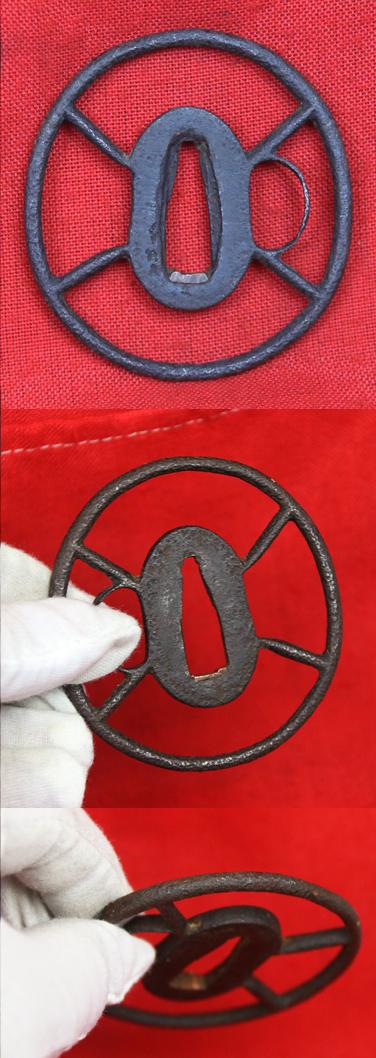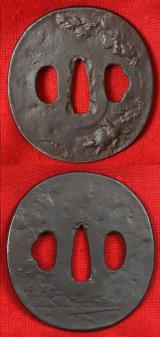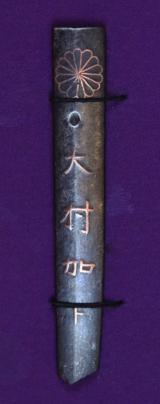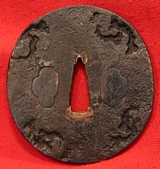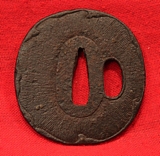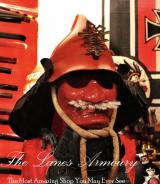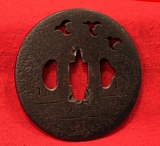Japanese
A Super Early Samurai Sword Katana Tsuba, Kanayama and Ono School
Kanayama and Ono school tettsu tsuba, Circa 1400
Kanayama Tsuba exhibit a well forged iron with a hammered surface with prominent Tsuchime similar to Owari Tsuba but with stronger Tekkotsu visible in the rim and surface. The origin of Kanayama tsuba is still not a hundred percent clear, but most sources name a city close to Nagoya in the Owari province. In the early Edo period Ono Tsuba developed out of the Kanayama school and continued their tradition with various designs but a bit smaller in size.
The Kanayama school
Beginning in mid Muromachi to the end of Genroku (ca. 1400 to 1710). For purposes of study, the period of production is divided into three sections: the first period is the Muromachi age, second period is Momoyama age, and the third period are the pieces made in Kyoto during the Edo age. Normally round, sometimes oval.
the tsuba's seppa dai is a very good shape, squarish at top and bottom. Usually Thickness 3 to 5.09mm. this tsuba is 5 mm thick . It appears slightly large for the size of the tsuba and slightly more oblong than those found on Owari tsuba.
Many tsuba of the school have thin, raised square peripheral rims (later examples have rounded rims) with 'tekkotsu' visible.
Design Characteristics:
This school would seem to be the earliest to use ji-sukashi (positive silhouette). Most of the designs are plain, direct, and abstract, consisting largely of straight or curved lines that produce a feeling of great dignity. The openwork is so extensive that the remaining metal portions are very fine and slender.
Antique Japanese koshirae [Japanese samurai sword mounts, tsuba and fittings] are considered as fine object d'art in their own right, and have been collectable as individual items or sets, since the Edo period. They were often removed from swords, mounted in small cases, and respectfully admired for display as items of the highest quality workmanship, and symbols of the noble samurai, in their own right. Some koshirae collectors never actually have any interest in the blades themselves, and individual pieces can attain values of tens of thousands of pounds, and there are many multi million pound collections, in and out of museums, comprising of some of the finest examples of Japanese un-mounted sword fittings from the samurai historical period.
70mm across read more
675.00 GBP
A Samurai’s String of 25 Edo Period Graduating Ojime Beads, Made For a Samurai’s Inro or Tobacco Pouches Netsuke Cords, Transformed into a Necklace
25 hand carved bone graduating sized ojime beads, in the form of intricate three dimensional flowers, and combined with 17 rice grain shaped beads. Today Antique Japanese Ojime beads remain highly collectable as pieces of art, as the amount of detail that went into the components of each Sagemono [hanging cord of inro or kizeru tobacco pouch] provides a further example of the exquisite beauty of Japanese art – alongside their calligraphy, block printing, ceramics, lacquer work, and paintings to name but a few. Ojime are handcrafted decorative beads which originated in Japan as early as the 16th century. Strictly speaking the word bead is superfluous as Ojime itself means cord fastener bead. They are typically under 1 inch in diameter with a vertical hole from top to bottom, and are made from fine metals, hornbill precious stones, jade, lacquer, tortoise shell, glass, coral, bone, stag antler, boar tooth and tusk, nuts and seeds, as well as other natural materials. As will become evident, aside from being decorative, they have a very specific role to perform in traditional Japanese attire and as such they go a long way towards defining the concept of adornment, namely that which is useful as well as beautiful.Although the Japanese did not have an appreciation of jewellery in the European sense, they did have a long tradition of craftsmanship, artistry, decoration and adornment. Over time these small sets of accessories became highly refined and sophisticated. It was in the Meiji Period (1868 to 1912) that the Inro became an indicator of wealth and taste and the Ojime evolved into a functional but beautifully crafted object incorporating symbolism, mythology, poetry and other themes from everyday life.
An inro is a traditional Japanese case for holding small objects, suspended from the obi (sash) worn around the waist when wearing a kimono. They are often highly decorated with various materials such as lacquer and various techniques such as maki-e, and are more decorative than other Japanese lacquerware. Approx 27 inches long, measured straight, in total, 13 3/4 inches long once in necklace form read more
425.00 GBP
A Nice Edo Period Round Iron Plate Tsuba Decorated with A Boy Riding a Water Buffalo
After Hanabusa Itchō, a very popular subject in Japnese art in the late 17th to 18th century.Tsuba were made by whole dynasties of craftsmen whose only craft was making tsuba. They were usually lavishly decorated. In addition to being collectors items, they were often used as heirlooms, passed from one generation to the next. Japanese families with samurai roots sometimes have their family crest (mon) crafted onto a tsuba. Tsuba can be found in a variety of metals and alloys, including iron, steel, brass, copper and shakudo. In a duel, two participants may lock their katana together at the point of the tsuba and push, trying to gain a better position from which to strike the other down. This is known as tsubazeriai pushing tsuba against each other. 68mm read more
245.00 GBP
A Very Nice Edo Period Shinto Era 'Nakago Form' Kodzuka
Iron body inlaid with copper , with the signature kanji of Kaboku, and the Imperial chrysanthemum mon. Kodzuka have been collectable items for many centuries, simply as works of art, even though they were functional knife handles, for the utility blades that fitted into wakizashi, tanto and katana saya. They can vary in quality, and this is a most fine example, inlaid with pure copper. What is particularly scarce is that it is shaped like the tang of the sword, complete with simulated mekugi ana, and signed in much the same way. This type is rare and very collectable. The kozuka handle would have a long thin blade that slotted into it's opening, and the blade was often considered to be almost of a disposable nature, with the handle itself being the prized part. 3.75" long. read more
550.00 GBP
A Super Edo Period Signed Samurai Sword Tsuba That Has Been Damaged in Sword Combat possibly by Tsubazeriai
A most fascinating result of sword to sword combat by two samurai, either a blade has struck the tsuba and been deflected, but in its progress, cutting off part of the tsuba, or, possibly by two samurai locking swords, tsuba to tsuba and this one has broken. either way it is most intriguing. In a duel, in kendo, two participants may lock their katana together at the point of the tsuba and push, trying to gain a better position from which to strike the other down. This is known as tsubazeriai pushing tsuba against each other. Tsuba were made by whole dynasties of craftsmen whose only craft was making tsuba. They were usually lavishly decorated. In addition to being collectors items, they were often used as heirlooms, passed from one generation to the next. Japanese families with samurai roots sometimes have their family crest (mon) crafted onto a tsuba. Tsuba can be found in a variety of metals and alloys, including iron, steel, brass, copper and shakudo. read more
345.00 GBP
A Good Antique Edo Period Iron Plate Tempo Tsuba
Tempo school and the yakite finish (heat treatment) is typical, as is the excellent iron. The smith who made this knew what he was doing; for all the wildness of the stamping it is very finely constructed. The patina is amazingly soft and velvety kozuka and kogai ana, on each side, 4 stamps of pairs of clouds? Kozuka and kogai hitsu ana (suhama); 74 mm read more
495.00 GBP
Iron Round Chisa Katana or Wakazashi Tsuba With Amidayasuri and Wave Rim
Koto period circa 1550 with very finely chisseled designs. Tsuba are usually finely decorated, and are highly desirable collectors' items in their own right. Tsuba were made by whole dynasties of craftsmen whose only craft was making tsuba. They were usually lavishly decorated. In addition to being collectors items, they were often used as heirlooms, passed from one generation to the next. Japanese families with samurai roots sometimes have their family crest (mon) crafted onto a tsuba. Tsuba can be found in a variety of metals and alloys, including iron, steel, brass, copper and shakudo. In a duel, two participants may lock their katana together at the point of the tsuba and push, trying to gain a better position from which to strike the other down. This is known as tsubazeriai pushing tsuba against each other. read more
375.00 GBP
Europe’s Leading Original Samurai Sword Specialists
After 50 years personal experience by Mark, since 1971, we are Europe’s leading samurai sword specialists, with hundreds of swords to view and buy online 24/7, or in our store on a personal visit, 6 days a week. In fact we know of no better and varied original samurai sword selection for sale under one roof outside of Japan, or probably, even within it. Hundreds of original pieces up to 800 years old. Whether we are selling to our clients representing museums around the globe, the world’s leading collectors, or simply a first time buyer, we offer our advice and guidance in order to assist and guide the next custodian of a fine Japanese sword, to make the very best choice for them.
Both of the partners of the company have spent literally all of their lives surrounded by objects of history, trained, almost since birth in the arts and history. Supervised and mentored, first by their grandfather, then their father, who left the RAF sometime after the war, to become one of the leading antique exporters and dealers in the entire world. Selling, around the whole world, in today’s equivalent, hundreds of millions of pounds of antiques and works of art. Both Mark and David were incredibly fortunate to be mentored by some of the world’s leading experts within their fields of antiques and militaria. Mark has been a director and partner in the family businesses since 1971, but long before that he was handling and buying swords and flintlocks since he was just seven years old, obviously in a very limited way though, naturally. David, Mark’s younger brother, also started collecting militaria when he was seven, and as you will by now guess, history, antiques and militaria is simply in their blood. read more
Price
on
Request
An Edo Sukashi Katana & Yari Tsuba Decorated With Birds In Flight
Made for a Katana but with a square section adaption to mount on a yard polearm as well. Tsuba were made by whole dynasties of craftsmen whose only craft was making tsuba. They were usually lavishly decorated. In addition to being collectors items, they were often used as heirlooms, passed from one generation to the next. Japanese families with samurai roots sometimes have their family crest (mon) crafted onto a tsuba. Tsuba can be found in a variety of metals and alloys, including iron, steel, brass, copper and shakudo. In a duel, two participants may lock their katana together at the point of the tsuba and push, trying to gain a better position from which to strike the other down. This is known as tsubazeriai pushing tsuba against each other. read more
295.00 GBP
A Magnificent Life Size Carving of A Samurai Warrior, by Woodcarver and Artist, Danny Reinhold
We are delighted to show the completed and most remarkable work of art, created and owned by Danny Reinhold of Germany, a most talented young man. We were very happy to assist him in a very small way, and he was very kind to acknowledge our assistance in his video.
His you tube film of making his armour can be watched through this link. Copy and Paste
https://www.youtube.com/watch?v=4zwT6lZZoC0
It took Danny 2500 hours, he constructed it with 12000 pieces, each hand carved and finished by hand, using 23 kinds of wood plus bone.
It is a simply stunning and a remarkable feat, and worthy of the highest praise
Not for sale read more
Price
on
Request


